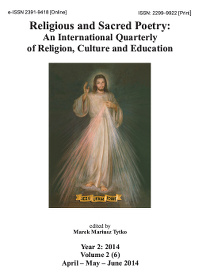Catholicism and Modernism in Bohemia and Slovakia in the First Half of the 20th Century
Catholicism and Modernism in Bohemia and Slovakia in the First Half of the 20th Century
Author(s): Edita PríhodováPublished by: Fundacja Naukowa Katolików »Eschaton«
Keywords: Catholicism; Secularisation; Modernism; Czech; Slovak Culture
Summary/Abstract: This paper deals with the mutual relationship between the process of modernisation and traditional religion (Christianity) in the context of European thinking at the turn of the 19th century, as well as in the first half of the 20th century. It analyses and synthetises the knowledge of Czech and Slovak literary scholarship concerning the literary and cultural activity of Catholic intellectuals and artists. The following comparison points out different methodological approaches and terminological concepts of Czech and Slovak literary history. The diverse cultural activity of Catholics (Catholic modernism, modern Catholic literature summarily referred to as Catholic aestheticism) in the environment of the first Czechoslovak republic (1918 – 1939) is understood as one of the first reactions to the process of the secularisation of society. In conjunction with the reactions of the Catholic Church against secularisation and modernisation at the level of high hierarchy (Papal encyclicals), they offer case materials for validating the secularisation and transformation theories which developed within the sociology of religion. The research has proved that the secularisation theory, which is based on the thesis of the incompatibility of religion and modern society, cannot be considered the absolute and sole paradigm of their relationship. Modernisation of society at the turn of the 19th century had an activating impact on Catholics, which supports the assertion of the transformation theory according to which religion will not be excluded from modern society, only the displays of religion of the modern man will change. The interdisciplinary and interliterary approach I used in my work enabled me to explain the complex cultural processes and their consequences, which are also characteristic of contemporary culture in the Central and Eastern European environment.
Journal: Religious and Sacred Poetry: An International Quarterly of Religion, Culture and Education
- Issue Year: 2014
- Issue No: 2
- Page Range: 65-90
- Page Count: 26

